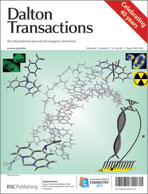The molecular structures of 1,2-closo-P2B10H10 (1) and 1,2-closo-As2B10H10 (2) have been determined by gas electron diffraction and the results obtained compared with those from computation at the MP2/6-31G** level of theory. The level of agreement is good for 2 (root-mean-square [rms] misfit for As and B atoms 0.0297 Å) and very good for 1 (rms misfit for P and B atoms 0.0082 Å). In comparing the structures of 1 and 2 with that of 1,2-closo-C2B10H12 (I) it is evident that expansion of the polyhedron from I to 1 to 2 is restricted only to the heteroatom vertices and the B6 face to which these are bound. Following deboronation (at B3) and subsequent metallation, compounds 1 and 2 have been converted into the new metalladiheteroboranes 3-(η-C9H7)-3,1,2-closo-CoAs2B9H9 (4), 3-(η-C10H14)-3,1,2-closo-RuAs2B9H9 (5), 3-(η-C5H5)-3,1,2-closo-CoP2B9H9 (6), 3-(η-C9H7)-3,1,2-closo-CoP2B9H9 (7) and 3-(η-C10H14)-3,1,2-closo-RuP2B9H9 (8), the last three constituting the first examples of metalladiphosphaboranes. Together with the known compound 3-(η-C5H5)-3,1,2-closo-CoAs2B9H9 (3), compounds 4–8 have been analysed by NMR spectroscopy and (except for 8) single-crystal X-ray diffraction. The 11B NMR spectra of analogous pairs of metalladiphosphaborane and metalladiarsaborane (6 and 3, 7 and 4, 8 and 5) reveal a consistently narrower (9–10 ppm) chemical shift range for the metalladiarsaboranes, the combined result of a deshielding of the lowest frequency resonance (B6) and an increased shielding of the highest frequency resonance (B8) via an antipodal effect. In crystallographic studies, compounds 3 and 5B (one of two crystallographically-independent molecules) suffer As/B disorder, but in both cases it was possible to refine distinct, ordered, components of the disorder, the first time this has been reported for metalladiarsaboranes. Moreover, whilst the Cp compounds 6 and 3 are disordered, their indenyl analogues 7 and 4 are either ordered or significantly less disordered, a consequence of both the reduced symmetry of an indenyl ligand compared to a Cp ligand and the preference of the former for a distinct conformation relative to the cage heteroatoms. Unexpectedly, whilst this conformation in the cobaltadiphosphaborane 7 is cis-staggered (similar to that previously established for the analogous cobaltadicarborane), in the cobaltadiarsaborane 4 the conformation is close to cis-eclipsed.


 Please wait while we load your content...
Please wait while we load your content...